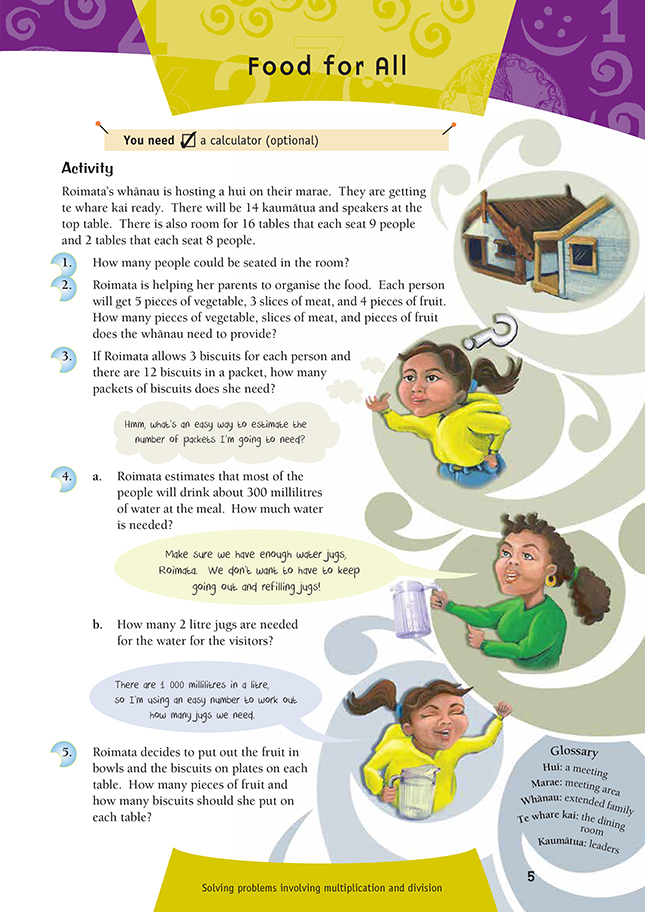This is a level 4 number activity from the Figure It Out series. It relates to Stage 7 of the Number Framework.
A PDF of the student activity is included.
Click on the image to enlarge it. Click again to close. Download PDF (264 KB)
solve multiplication and division story problems
FIO, Level 3-4, Number, Book 2, Food for All, page 5
A calculator (optional)
This activity involves estimation, multiplication, and division. Students at the advanced multiplicative stage of the Number Framework should be able to solve the questions in this activity mentally, while those at the advanced additive stage may need to use a calculator.
Before starting on the questions in this activity, have the students sketch a table plan for te whare kai. This should get them thinking about multiplicative strategies for finding the total number of people in question 1. For example, to find 16 x 9, they could use known facts, such as 8 x 9, or rounding and compensation, such as 16 x 10 – 16.
The students need to apply their answer for question 1 to work out the answer for question 2. They can solve question 2 using a variety of methods, including mental strategies. For example, 174 x 5 can be seen as half of 174 x 10, applying knowledge of the tens strategy. 174 x 4 can be treated as 174 x 5 – 174 or 174 x 2 x 2 (double and double again), and 174 x 3 can be seen as 58 x 9 (dividing by 3 and trebling), which in turn can be seen as 58 x 10 – 60 + 2. Another strategy
for 174 x 3 is to double 174 and add 174.
In question 3, there are various ways that the students can find to estimate the number of packets needed. For example, they can multiply the 3 biscuits per person by the total number of people to give the total number of biscuits needed. This total can then be divided by 12 to give the number of packets. Alternatively, the students may see that each packet of biscuits will feed 4 people. 174 ÷ 4 = number of packets needed to feed the people at the hui. One strategy is to halve 174, then halve 87.
You may need to remind some students that you cannot buy half a packet, so the answer of 43.5 will need to be rounded up to 44 packets.
In question 4a, the students can calculate their answer in litres or millilitres. Either way, they are looking at 174 x 300 millilitres. You could encourage the students to estimate this first. Some students may recognise the similarities between 174 x 300 and 174 x 3, which they had to calculate for question 2. Roimata hints at an easy way to answer question 4b. Some students may prefer Roimata’s method to dividing by 2000.
In question 5, the students need to remember that the number of people sitting at different tables varies (14, 9, and 8). They also need to refer back to the proportions of food to people given in questions 2 and 3 and multiply these proportions by the number of people at the various-sized tables.
Answers to Activity
1. 174. (14 + [16 x 9] + [2 x 8]. Strategies for 16 x 9 will vary.)
2. 870 pieces of vegetable (174 x 5), 522 slices of meat (174 x 3), and 696 pieces of fruit (174 x 4). (Strategies for multiplying by 5, 4, and 3 will vary.)
3. 44 packets. (Each packet feeds 12 ÷ 3 = 4 people. 174 ÷ 4 = 43.5. Or: 174 x 3 = 522. 522 ÷ 12 = 43.5)
4. a. 52 200 mL, which is 52.2 L
b. 27. (52 000 ÷ 2 000 = 26 or 52 000 ÷ 1 000 = 52. Half of 52 is 26. An
extra jug would be needed for the 200 mL.)
5. 56 pieces of fruit and 42 biscuits at the top table, 36 pieces of fruit and 27 biscuits at each table seating 9, and 32 pieces of fruit and 24 biscuits at each table seating 8
